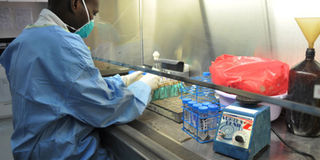New tuberculosis test developed

A laboratory attendant arranges samples of TB tests at Mulago National Referral Hospital. Diagnosing the disease is still a challenge in the country. Photo by Rachel Mabala
What you need to know:
The new research used an inhaled form of isoniazid - an antibiotic commonly used to treat the disease - which is activated by a TB enzyme.
Researchers have developed the first breath test for tuberculosis in the laboratory. It provides rapid information on drug resistance that takes up to six weeks using standard methods, US scientists report in the journal, Nature Communications.
The bacteria emit a unique gas signature within 10 minutes of exposure to an inhaled antibiotic in rabbits. TB infects 8.6m people each year worldwide and kills 1.3m, second only to HIV.
Early diagnosis and treatment is crucial in the global fight against TB, according to the World Health Organisation.
New research
The new research used an inhaled form of isoniazid - an antibiotic commonly used to treat the disease - which is activated by a TB enzyme.
The test exploits the fact that this enzyme is unique to TB. We realised that we could actually look at the conversion of isoniazid to its active form by monitoring one of the labelled gases that is given off during its activation,” said Dr Graham Timmins, associate professor at the University of New Mexico, US, who led the research.
The researchers gave a special molecularly-labelled form of isoniazid to laboratory rabbits.
In the presence of TB, labelled nitrogen gas was released from the lungs and detected by a machine called a mass spectrometer.
A positive result indicates that TB bugs are present and suggests they are susceptible to isoniazid.
Treatment options
TB is difficult to treat, requiring at least six months of treatment with multiple drugs.
Failure to complete treatment has contributed to the rise of multidrug-resistant TB (MDR-TB) in high risk countries. For many years diagnosis of TB relied on a lengthy wait for the bacteria to grow in a culture of the patient’s sputum. “If you do it by culture, it can take a month to six weeks before you get a result,” said Dr Timmins.
In the last few years a new DNA detection technique called GeneXpert has been endorsed by WHO.
From a sample of sputum it can detect whether a sample contains TB and whether it is resistant to one of the key drugs, rifampicin, in about three hours.
But for full drug resistance information, the patient has to wait longer. The new breath test samples the whole lung for what is hoped will be greater sensitivity, in a wider range of patients, with results available almost instantly.
Clever idea
“It is a clever idea. The test could add a bit more certainty to the diagnosis of multi-drug resistant TB, and it is worth pursuing,” said Dr Ruth McNerney, a senior lecturer at the London School of Hygiene and Tropical Medicine.
At present, the breath test only detects isoniazid sensitivity. It will therefore need to be used in combination with other tests. “This is just the start of the programme we want to instigate. The next step will be to show that the tests work in humans in a clinical setting,” said Dr Timmins.
Testing in Uganda
The smear microscopy procedure is the current method used to test TB in Uganda. However, it has been faulted as the reason behind the high numbers of undiagnosed cases. The procedure involves collecting a sputum sample, then viewing the TB bacterium through a microscope glass. However, this method can only detect 50 per cent of all cases.
-BBC




